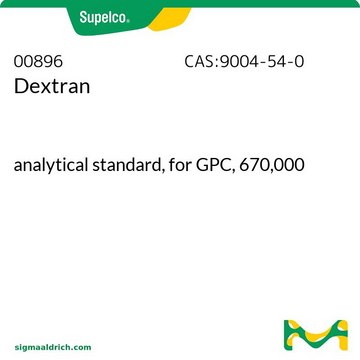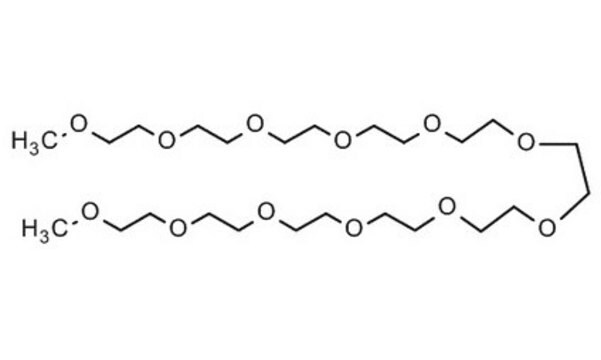8.18892
Poly(éthylène glycol)
35000, (stabilised with 2-tert-butyl-4-methoxyphenol) for synthesis
Synonyme(s) :
PEG
About This Item
Produits recommandés
Pression de vapeur
<0.01 hPa ( 20 °C)
Niveau de qualité
Forme
liquid
Température d'inflammation spontanée
>320 °C
Puissance
28000 mg/kg LD50, oral (Rat)
>20000 mg/kg LD50, skin (Rabbit)
pH
5-7 (20 °C, 100 g/L in H2O)
Pf
60-65 °C
Température de transition
flash point 260 °C
Solubilité
500 g/L
Densité
1.2 g/cm3 at 20 °C
Masse volumique apparente
400‑500 kg/m3
Température de stockage
2-30°C
Chaîne SMILES
C(CO)O
InChI
1S/C2H6O2/c3-1-2-4/h3-4H,1-2H2
Clé InChI
LYCAIKOWRPUZTN-UHFFFAOYSA-N
Vous recherchez des produits similaires ? Visite Guide de comparaison des produits
Application
- Hierarchically structured silica monoliths for the fabrication of micro-bioreactors.
- Micro-nanostructured PEG-DA (PEG-diacrylates) hydrogels for biomedical applications.
It can also be used as:
- A template to prepare micro/mesoporous structure of silica by sol-gel process.
- A stabilizing agent in the synthesis of metal nanoparticles.
Remarque sur l'analyse
Melting range (lower value): ≥ 62 °C
Melting range (upper value): ≤ 67 °C
Average molecular mass: 28000 - 38000
Identity (IR): passes test
Code de la classe de stockage
10 - Combustible liquids
Classe de danger pour l'eau (WGK)
WGK 1
Point d'éclair (°F)
281.5 °F - closed cup
Point d'éclair (°C)
138.6 °C - closed cup
Certificats d'analyse (COA)
Recherchez un Certificats d'analyse (COA) en saisissant le numéro de lot du produit. Les numéros de lot figurent sur l'étiquette du produit après les mots "Lot" ou "Batch".
Déjà en possession de ce produit ?
Retrouvez la documentation relative aux produits que vous avez récemment achetés dans la Bibliothèque de documents.
Les clients ont également consulté
Notre équipe de scientifiques dispose d'une expérience dans tous les secteurs de la recherche, notamment en sciences de la vie, science des matériaux, synthèse chimique, chromatographie, analyse et dans de nombreux autres domaines..
Contacter notre Service technique


